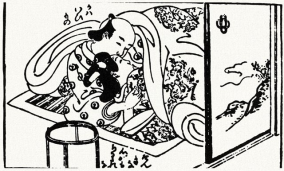Nanshoku

Nanshoku (男色), the premodern Japanese word for eroticism between adult and adolescent males, was the longest lived and most public expression of same-sex affection anywhere in the world.[1]
Among the analogous Japanese terms for male-male sex, such as "the way of youths" (wakashudō, often abbreviated as jakudō or shudō), the "way of men" (nandō), "the beautiful way" (bidō) and the "secret way" (hidō), "male eros" (nanshoku) was probably used most widely in the Tokugawa period (1603–1868). The word is the Japanese reading of the Chinese term nanse, which is written with the characters for "male" (男) and "color" (色). The latter character has been understood as a euphemism for sex in China since ancient times (possibly as a result of the association between women's cosmetics and eroticism), and both Chinese and Japanese dictionaries include "sensual pleasure" as one of its definitions.[2]
References
- ↑ Nanshoku Male-Male Eroticism in Japan (Ipce)
- ↑ Gary P. Leupp, Male Colors: The Construction of Homosexuality in Tokugawa Japan (Berkeley: University of California Press, 1995), pp. 1–12.

